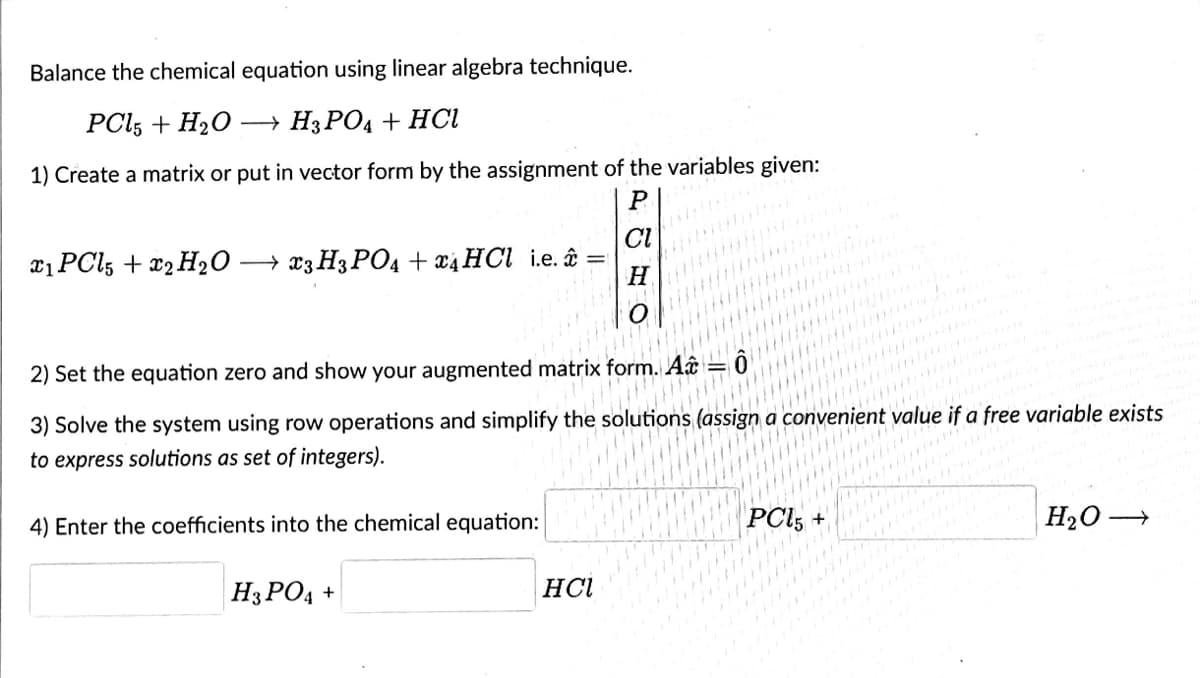Balance the chemical equation using linear algebra technique. PCL5 + H₂O →→ H3PO4 + HCl 1) Create a matrix or put in vector form by the assignment of the variables given: x1 PCl5 + 2H₂O3 H3PO4 + x4 HCl i.e. = 2) Set the equation zero and show your augmented matrix form. A 3) Solve the system using row operations and simplify the solutions (assign a convenient value if a free variable ex to express solutions as set of integers). 4) Enter the coefficients into the chemical equation: PC15 + H₂O H3PO4 + Respon HCI PUHO
Balance the chemical equation using linear algebra technique. PCL5 + H₂O →→ H3PO4 + HCl 1) Create a matrix or put in vector form by the assignment of the variables given: x1 PCl5 + 2H₂O3 H3PO4 + x4 HCl i.e. = 2) Set the equation zero and show your augmented matrix form. A 3) Solve the system using row operations and simplify the solutions (assign a convenient value if a free variable ex to express solutions as set of integers). 4) Enter the coefficients into the chemical equation: PC15 + H₂O H3PO4 + Respon HCI PUHO
Chemistry
10th Edition
ISBN:9781305957404
Author:Steven S. Zumdahl, Susan A. Zumdahl, Donald J. DeCoste
Publisher:Steven S. Zumdahl, Susan A. Zumdahl, Donald J. DeCoste
Chapter1: Chemical Foundations
Section: Chapter Questions
Problem 1RQ: Define and explain the differences between the following terms. a. law and theory b. theory and...
Related questions
Question
Please Answer in step by step solution

Transcribed Image Text:Balance the chemical equation using linear algebra technique.
PCl5 + H₂O →→ H3PO4 + HCl
1) Create a matrix or put in vector form by the assignment of the variables given:
P
CI
x1 PCl5 + 2 H₂O →x3 H3PO4 + x4 HCl i.e.
H
2) Set the equation zero and show your augmented matrix form. A
3) Solve the system using row operations and simplify the solutions (assign a convenient value if a free variable exists
to express solutions as set of integers).
4) Enter the coefficients into the chemical equation:
PCI5+
H₂O-
→
H3PO4 +
HCl
Expert Solution
This question has been solved!
Explore an expertly crafted, step-by-step solution for a thorough understanding of key concepts.
This is a popular solution!
Trending now
This is a popular solution!
Step by step
Solved in 3 steps

Knowledge Booster
Learn more about
Need a deep-dive on the concept behind this application? Look no further. Learn more about this topic, chemistry and related others by exploring similar questions and additional content below.Recommended textbooks for you

Chemistry
Chemistry
ISBN:
9781305957404
Author:
Steven S. Zumdahl, Susan A. Zumdahl, Donald J. DeCoste
Publisher:
Cengage Learning

Chemistry
Chemistry
ISBN:
9781259911156
Author:
Raymond Chang Dr., Jason Overby Professor
Publisher:
McGraw-Hill Education

Principles of Instrumental Analysis
Chemistry
ISBN:
9781305577213
Author:
Douglas A. Skoog, F. James Holler, Stanley R. Crouch
Publisher:
Cengage Learning

Chemistry
Chemistry
ISBN:
9781305957404
Author:
Steven S. Zumdahl, Susan A. Zumdahl, Donald J. DeCoste
Publisher:
Cengage Learning

Chemistry
Chemistry
ISBN:
9781259911156
Author:
Raymond Chang Dr., Jason Overby Professor
Publisher:
McGraw-Hill Education

Principles of Instrumental Analysis
Chemistry
ISBN:
9781305577213
Author:
Douglas A. Skoog, F. James Holler, Stanley R. Crouch
Publisher:
Cengage Learning

Organic Chemistry
Chemistry
ISBN:
9780078021558
Author:
Janice Gorzynski Smith Dr.
Publisher:
McGraw-Hill Education

Chemistry: Principles and Reactions
Chemistry
ISBN:
9781305079373
Author:
William L. Masterton, Cecile N. Hurley
Publisher:
Cengage Learning

Elementary Principles of Chemical Processes, Bind…
Chemistry
ISBN:
9781118431221
Author:
Richard M. Felder, Ronald W. Rousseau, Lisa G. Bullard
Publisher:
WILEY